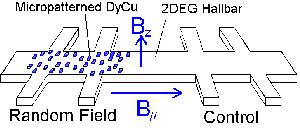Why is it interesting?
Experimental Setup
Results
The issue of two-dimensional electron system (2DES) in random magnetic field is of particular interest from some aspects.
| The sample is a Hallbar of GaAs 2DES decorated with randomly
patterned magnetic film, an alloy of Dy and Cu. This material has a large
saturation magnetic moment that makes a large field modulation on the 2DES,
but does not have a spontaneous magnetization at helium temperature. So
the amplitude of the field modulation can be controlled continuously from
zero.
The actual sample looks like the right figure. The characteristic length scale of the randomness is about 1 micron. This is fairly shorter than the mean free path of the electron, which is about 10 micron. Random field is produced by magnetizing the patterned DyCu by an external magnetic field. By applying this external field pararell to the 2D plane, a random field with practically zero mean is produced. We also have a small magnet that can apply a uniform perpendicular field independently to the sample. |

Schematic illustration of the sample
SEM image of the sample |
| First to study the effect of zero-mean random field, a in-plane
field is applied. It is obvious that the resistance of the random field
sample (red line) shows a larger increase
with increasing in-plane field than that of the control sample (blue
line).
This increase in the resistivity is roughly proportional to the square of the magnetization of the DyCu film ( green marks: measured with SQUID magnetometer ). Next, keeping the random field modulation fixed, we measured the magnetoresistance to uniform field component. The resistivity curve resembles that of a plain 2DES without random magnets, but in high field region around the HFLL state! The common features are
This implies the relevance between the composite fermion and random
field problem. |

Dependence on in-plane field
Magnetoresistance in fixed random field component |